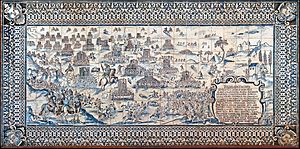
DomAfonso VI, known as "the Victorious", was the second king of Portugal of the House of Braganza from 1656 until his death. He was initially under the regency of his mother, Luisa de Guzmán, until 1662, when he removed her to a convent and took power with the help of his favourite, the Luís de Vasconcelos e Sousa, 3rd Count of Castelo Melhor.

Frederick Herman de Schomberg, 1st Duke of Schomberg KG PC was a German-born military officer and peer who served as Master-General of the Ordnance from 1689 to 1690. Having fought in the French, Portuguese and English armies, he was killed in action fighting on the Williamite side at the Battle of the Boyne in 1690.

The Iberian Union is a historiographical term used to describe the dynastic union of the Monarchy of Spain, which in turn was itself a personal union of the crowns of Castile and Aragon, and the Kingdom of Portugal, and of their respective colonial empires, that existed between 1580 and 1640 and brought the entire Iberian Peninsula except Andorra, as well as Portuguese and Spanish overseas possessions, under the Spanish Habsburg monarchs Philip II, Philip III, and Philip IV. The union began after the Portuguese succession crisis of 1580 and the ensuing War of the Portuguese Succession, and lasted until the Portuguese Restoration War, during which the House of Braganza was established as Portugal's new ruling dynasty with the acclamation of John IV as the new king of Portugal.
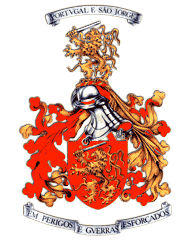
The Portuguese Army is the land component of the Armed Forces of Portugal and is also its largest branch. It is charged with the defence of Portugal, in co-operation with other branches of the Armed Forces. With its origins going back to the 12th century, it can be considered one of the oldest active armies in the world.

The Battle of Montijo was fought on 26 May 1644, in Montijo, Spain, between Portuguese and Spanish forces. Although the battle ended with a Portuguese victory, the Spanish saw it as a strategic success as they claimed to have prevented Matias de Albuquerque from capturing Badajoz, despite Albuquerque having no intention of attacking that city. Due to the chaotic nature of the battle, its outcome is debated and casualty figures vary.

The Battle of the Lines of Elvas, was fought on 14 January 1659, in Elvas, between Portugal and Spain during the Portuguese Restoration War. It ended in a decisive Portuguese victory.
The Battle of Tamames was lost by part of Marshal Michel Ney's French army under General of Division Jean Marchand in the Peninsular War. The French, advancing out of Salamanca, were met and defeated in battle by a Spanish army on 18 October 1809.
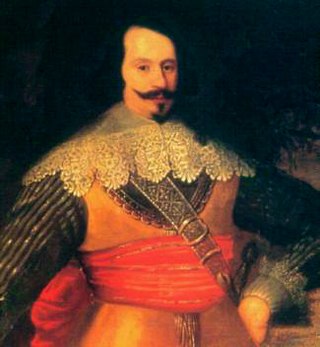
Luis Francisco de Benavides Carrillo de Toledo, Marquis of Caracena, Marquis of Fromista was a Spanish general and political figure. He served as Governor of the Habsburg Netherlands between 1659 and 1664.
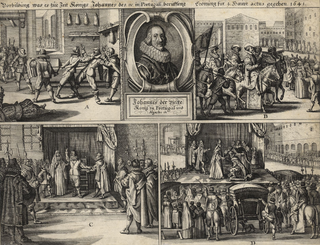
The Restoration War, historically known as the Acclamation War, was the war between Portugal and Spain that began with the Portuguese revolution of 1640 and ended with the Treaty of Lisbon in 1668, bringing a formal end to the Iberian Union. The period from 1640 to 1668 was marked by periodic skirmishes between Portugal and Spain, as well as short episodes of more serious warfare, much of it occasioned by Spanish and Portuguese entanglements with non-Iberian powers. Spain was involved in the Thirty Years' War until 1648 and the Franco-Spanish War until 1659, while Portugal was involved in the Dutch–Portuguese War until 1663.

António Luís de Meneses, 1st Marquis of Marialva and 3rd Count of Cantanhede was a member of the Forty Conspirators and a Portuguese general who fought in the Portuguese Restoration War, that ended the Iberian Union between Portugal and Spain.
The Treaty of Lisbon of 1668 was a peace treaty between Portugal and Spain that was concluded at Lisbon on 13 February 1668 with the mediation of England in which Spain recognised the sovereignty of Portugal's new ruling dynasty, the House of Braganza.

The Battle of Ameixial, was fought on 8 June 1663, near the village of Santa Vitória do Ameixial, some 10 kilometres (6.2 mi) north-west of Estremoz, between Spanish and Portuguese as part of the Portuguese Restoration War. In Spain, the battle is better known as the Battle of Estremoz.
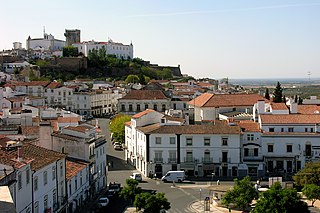
Estremoz is a municipality in Portugal. The population in 2011 was 14,318, in an area of 513.80 km2. The city Estremoz itself had a population of 7,682 in 2001. It is located in the Alentejo region.
The Battle of Vilanova took place on 17 September 1658 during the Portuguese Restoration War near the Fort of São Luis de Gonzaga, located south of Tui in the southern bank of the Minho River. A Spanish army commanded by the Governor of Galicia, Rodrigo Pimentel, Marquis of Viana, entered Portuguese territory and confronted a Portuguese army led by João Rodrigues de Vasconcelos e Sousa, 2nd Count of Castelo Melhor. The Spanish were victorious and proceeded over the following months to capture Monção, Salvaterra de Miño and other Portuguese strongholds.

The fourth siege of Badajoz took place from July to October 1658 during the Portuguese Restoration War. It was an attempt by a huge Portuguese army under the command of Joanne Mendes de Vasconcelos, governor of Alentejo, to capture the Spanish city of Badajoz, which was the headquarters of the Spanish Army of Extremadura. The fortifications of Badajoz were essentially medieval and considered vulnerable by the Portuguese, and had already been attacked by them three times during this war.
The Battle of La Gudiña, Battle of Val Gudina, or Battle of Campo Maior, was fought on 7 May 1709 near Arronches between the Spanish Bourbon army of Extremadura, under the Marquis de Bay, and the Portuguese and British, under the Huguenot Earl of Galway and the Marquis of Fronteira. This battle resulted in a crushing defeat for the Anglo-Portuguese army, 4,000-5,000 soldiers were killed, wounded or captured, while the Spanish had only 400 soldiers dead or wounded.

The Monument to the Restorers is a monument located in Restauradores Square in Lisbon, Portugal. The monument memorializes the victory of the Portuguese Restoration War. The war, which saw the end of the House of Habsburg and the rise of the House of Braganza, lasted from 1640 to 1668. The monument was designed by António Tomás da Fonseca and erected in 1886.
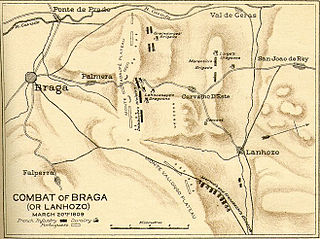
The Battle of Braga or Battle of Póvoa de Lanhoso or Battle of Carvalho d'Este saw an Imperial French corps led by Marshal Nicolas Soult attack a Portuguese army commanded by Baron Eben. When Soult's professional soldiers attacked, the Portuguese at first fought back but soon ran away. The French slaughtered large numbers of their opponents, who were mostly badly disciplined and poorly armed militia. The action was part of the second invasion of Portugal, during the Peninsular War.

D. Luís de Meneses, 3rd Count of Ericeira was a Portuguese nobleman, military man, historian, and politician.

The English expedition to Portugal was a military expedition dispatched by England to Portugal in August 1662 to participate in the Portuguese Restoration War against Spain. It consisted of an English brigade largely drawn from veterans of the Eighty Years' War and the Wars of the Three Kingdoms, which fought in several major battles and skirmishes of the conflict under the command of Frederick Schomberg. The brigade remained in Portugal until the conflict's end in 1668, when it was disbanded. Under Schomberg's leadership, the brigade proved to be a decisive factor in the eventual Portuguese victory in the conflict.
